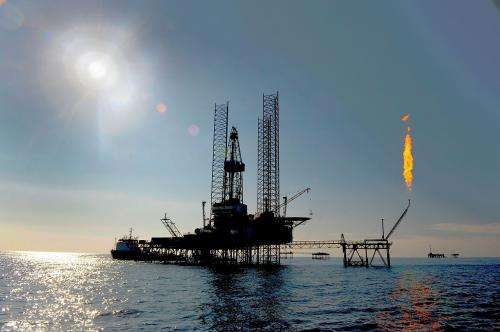Sea floor conditions mimicked for drilling platforms

Mobile jack-up drilling platforms used in the oil and gas industry are at risk of rejection before installation due to their use in harsher environments and deeper waters—but University of WA scientists have developed a model that will remove uncertainty and minimise risk, potentially widening their operating envelope.
The research from UWA's Centre for Offshore Foundation Systems is the first to systematically investigate the response of jack-up footings in soft clay, using computer modelling and physical experiments.
Previous studies have been limited to the different behaviour observed in stiff clay.
Study author Britta Bienen says while the difference in soil conditions may sound subtle, it changes the response considerably.
"Mobile jack-up platforms must pass a performance assessment before being approved to go on location," Dr Bienen says.
"This requires the response of the platform to be predicted under storm-loading conditions. The foundations play an important part in the platform's behaviour and can be the determining factor whether a jack-up is accepted or rejected for a site.
"The foundation model previously available for jack-up footings in clay did not account for the deep footing penetration in soft clay – where soil comes to rest on top of the footing – and thus overlooked available capacity.
"An analogy might be the relative ease with which a gumboot may be moved around on the surface of stiff clay, while it is a lot more difficult if it's sunk deeply into soft mud."
The experimental part of the study also represented a major development with researchers creating a new VHM (vertical, horizontal and moment) actuator, which took more than a year to design, manufacture, commission and use in the experiments.
It can move a footing in three directions independently within a geotechnical centrifuge, opening up whole new avenues of research.
"'Spinning' the soil sample in a centrifuge is important to get the stresses right so the same mechanisms occur as in the field," Dr Bienen says.
"While a soil sample of 200mm depth on the lab floor represents exactly that, the same sample when accelerated to 200 times the Earth's gravity is representative of a soil body 40m deep.
"In combination with footing models that are similarly scaled, the prototype behaviour can be investigated systematically under controlled conditions.
"Because the new VHM actuator allows the footing to be moved in a precisely controlled manner in different directions, a three-dimensional envelope of loads that can be sustained by the footing can be mapped in a series of experiments like this. This information forms the basis of the predictive model."
More information: Youhu Zhang, Britta Bienen, Mark J. Cassidy, "Jack-up push-over analyses featuring a new force resultant model for spudcans in soft clay," Ocean Engineering, Volume 81, 1 May 2014, Pages 139-149, ISSN 0029-8018, dx.doi.org/10.1016/j.oceaneng.2014.02.008.
Provided by Science Network WA


















